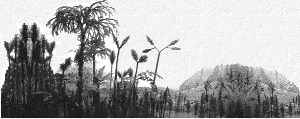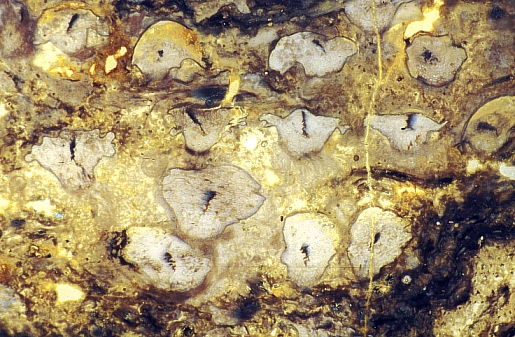
Longitudinal section of
Asteroxylon mackiei |
Asteroxylon mackiei, one
of the earliest lycopods, is the only plant from the Rhynie Chert which
had already small leaf-like structures. These, however, lacked a
vein. The central stele consists of a very characteristic massive,
star-shaped xylem surrounded by phloem (actinostele). The central stele
gives of leaf traces which end just at the base of the "leaves".
The development of a relatively complex star-shaped vascular strand in
Asteroxylon resulted in a considerable increase of the exchange
surface between the vascular bundle and the cortex. It also resulted
in a much greater stability of the plant, although the number of cells
which make up the xylem that provides stability has been kept to a real minimum.
Asteroxylon
could be up to 40 cm high and the creeping, naked rhizome formed repeatedly
bifurcating root-like organs which could reach up to 20 cm deep.
These latter structures are not true roots because a calyptra, a cap-like
structure on the tip of the root, is missing. The foliated aerial
axes bifurcated and borne many additional lateral axes. The up to
5 mm long leaves were spirally attached. The kidney-shaped sporangia
were scattered, standing on short stalks in the axils of normal
"leaves".
In comparison to other Rhynie Chert plants Asteroxylon has a rather
complex organization. The development of leaves resulted in a considerable
increase of the photosynthetic surface. The plant was probably
better able to regulate humidity by keeping dew drops between the
leaves.
This might imply that Asteroxylon was much better able to regulate
its water household than the other Rhynie Chert plants. The stomatal
density of Asteroxlon is about ten times higher than that of
Aglaophyton.
Unlike other Rhynie Chert plants, Asteroxylon could probably survive in temporarily drier
environments. An overview of the rooting
strategies of Rhynie Chert plants is given in the table below:
|




